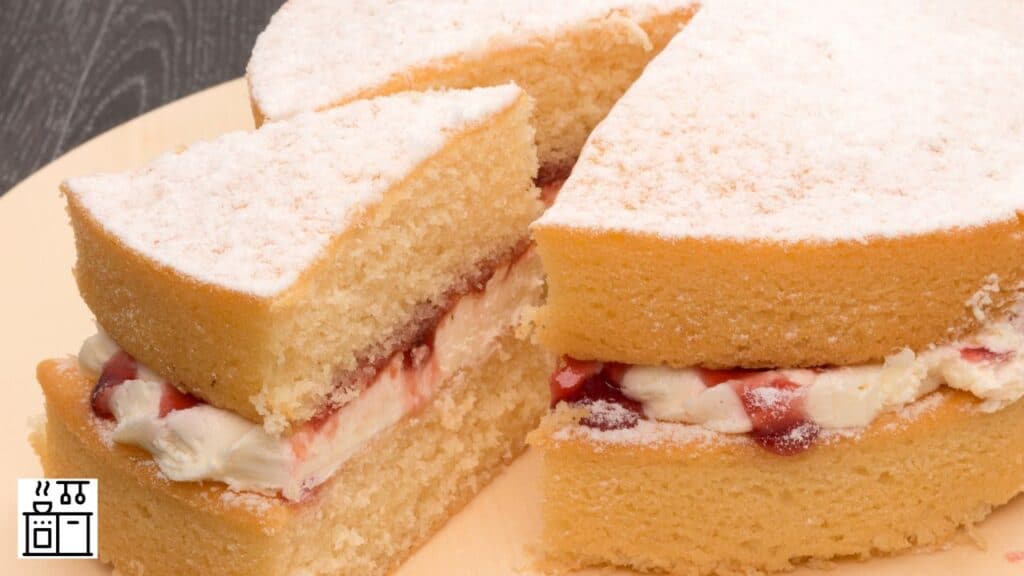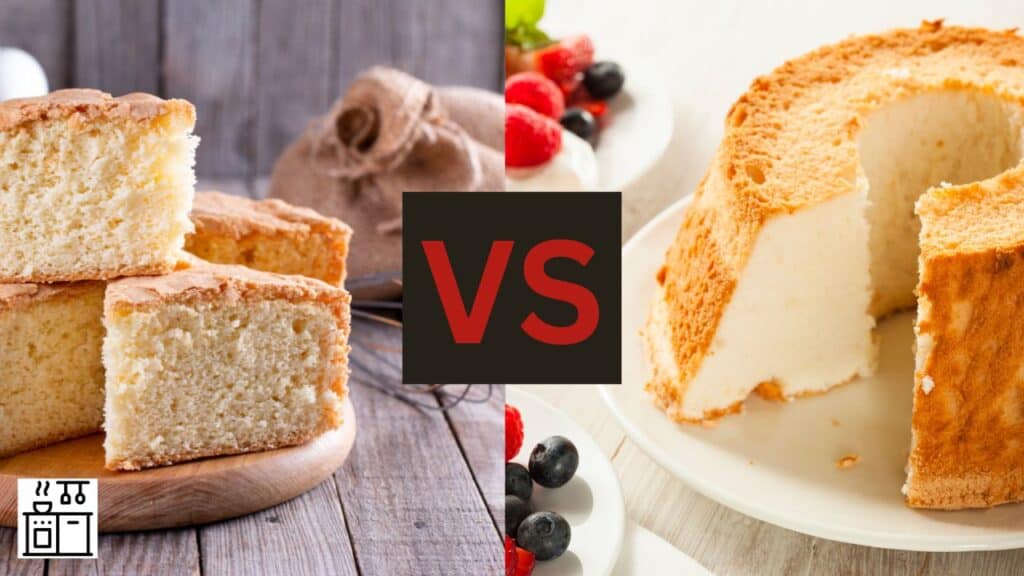Sponge cake is prepared using whole eggs and all-purpose flour, leading to a slightly dense and tender texture. It can be customized with various flavors like lemon zest or cocoa powder.
Angel food cake, however, is made with egg whites and cake flour, resulting in a light, melt-in-your-mouth texture. Despite being light, it pairs well with toppings such as fresh fruit or chocolate sauce.
The process of making sponge cake involves whipping egg whites and yolks separately to incorporate air, before combining them, which results in a denser texture.
On the contrary, angel food cake is made by whipping egg whites to stiff peaks and then gently folding them into the batter, helping to achieve a delicate texture.
Given below are all the differences between sponge cake and angel food cake.
- Ingredient Differences Between Sponge Cake and Angel Food Cake
- Texture Differences Between Sponge Cake and Angel Food Cake
- Difference of Flour Types Used in Sponge Cake and Angel Food Cake
- Difference in Egg Usage Between Sponge Cake and Angel Food Cake
- Difference in Preparation Methods of Sponge Cake and Angel Food Cake
Ingredient Differences Between Sponge Cake and Angel Food Cake
The primary difference between sponge cake and angel food cake lies in the type of eggs used. Sponge cake requires whole eggs, contributing to its rich flavor. Conversely, angel food cake utilizes only egg whites, leading to a lighter taste and texture.
However, the differences don’t end there. The flour type also significantly affects the final product. To understand this further, here are three points:
- Eggs: Sponge cakes incorporate whole eggs, whereas angel food cakes use only egg whites. This difference explains the variation in taste and texture between the two cakes.
- Flour: All-purpose flour is suitable for sponge cakes and is commonly found in most kitchens. In contrast, angel food cakes need cake flour for their unique fine texture.
- Taste and Texture: The use of whole eggs and all-purpose flour results in a denser, richer tasting sponge cake. Angel food cakes, made with egg whites and cake flour, are lighter in both taste and texture.
Texture Differences Between Sponge Cake and Angel Food Cake
Sponge cake has a slightly denser texture due to its light and fluffy yet substantial crumb. Angel food cake, in contrast, is delicate. It’s light and airy, almost dissolving on the tongue because it’s made using only egg whites and a specific preparation technique.
The ingredients and preparation methods are what create these distinct textures.
For instance, cake flour used in angel food cake contributes to its lightness. This flour is delicate and low in protein, so it doesn’t weigh down the egg whites, keeping the texture airy.
Here are the main differences between the two:
| Sponge Cake | Angel Food Cake |
|---|---|
| Denser texture and tender crumb | Light, melt-in-your-mouth texture |
| Uses raising agents, a fat, and whole eggs | Only uses egg whites |
| Has a heavier texture | Has a light and airy texture |
| Suitable for those wanting a richer dessert | Ideal for those wanting a light dessert |
Difference of Flour Types Used in Sponge Cake and Angel Food Cake

The type of flour used in baking significantly affects the texture of the dessert.
This is particularly noticeable when comparing denser desserts like sponge cake and lighter ones like angel food cake. The protein content of the flour plays a key role in this.
- All-Purpose Flour: Sponge cakes usually use all-purpose flour, which has a moderate protein content. The protein contributes to the denser texture of sponge cake. This kind of flour enables the cake to maintain its shape and provides a slightly chewy texture.
- Cake Flour: Angel food cakes typically use cake flour. This flour is more finely milled and has less protein. The lower protein content prevents the angel food cake from becoming too dense, letting the egg whites keep their light and airy structure.
- Texture Results: A slice of sponge cake will have a denser, firmer texture than an angel food cake, which is tender and melts in your mouth. This difference is due to the type of flour used.
Difference in Egg Usage Between Sponge Cake and Angel Food Cake
Sponge cake uses whole eggs, which imparts a rich flavor and dense texture. The process involves whipping the yolks and whites separately and then merging them to create a the batter. This utilization of the whole egg gives sponge cake its unique taste and texture.
On the other hand, angel food cake exclusively uses egg whites. These are whipped into soft peaks and then gently folded into the batter. This method results in a light, airy texture and subtle flavor, characteristic of angel food cake.
Here is a basic comparison table to illustrate the differences:
| Sponge Cake | Angel Food Cake |
|---|---|
| Utilizes whole eggs | Only uses egg whites |
| Has a richer flavor | Has a lighter flavor |
| Features a denser texture | Has an airy texture |
| Separately whips whites and yolks | Whips whites into soft peaks |
| Yolks contribute to flavor | Lack of yolks makes it lighter |
Related Reading: Pound Cake vs. Angel Food Cake
Difference in Preparation Methods of Sponge Cake and Angel Food Cake
For a sponge cake, the main focus is on whipping egg whites and yolks separately, then mixing them with salt and cream of tartar. On the other hand, making an angel food cake requires a completely grease-free process to prevent the cake from falling.
Here’s a closer look:
- Sponge Cake: Whip egg whites and yolks separately, then mix with salt and cream of tartar. Add this to eggs, sugar, and flour. No butter is required. Combine the batter thoroughly, pour into a cake pan, and bake until a toothpick comes out clean from the center.
- Angel Food Cake: Start with a thorough cleaning to eliminate any grease. Beat egg whites until stiff peaks form, then add cream of tartar and extracts. Gently fold in dry ingredients, including cake flour, to maintain lightness. Pour the batter into a parchment-lined tube pan and bake at 325°F for roughly an hour. After baking, invert the angel food cake pan onto a plate to cool. This unique method helps preserve its light texture.
The result of these methods is two cakes with different textures: sponge cake is slightly denser, while angel food cake is light and soft.

